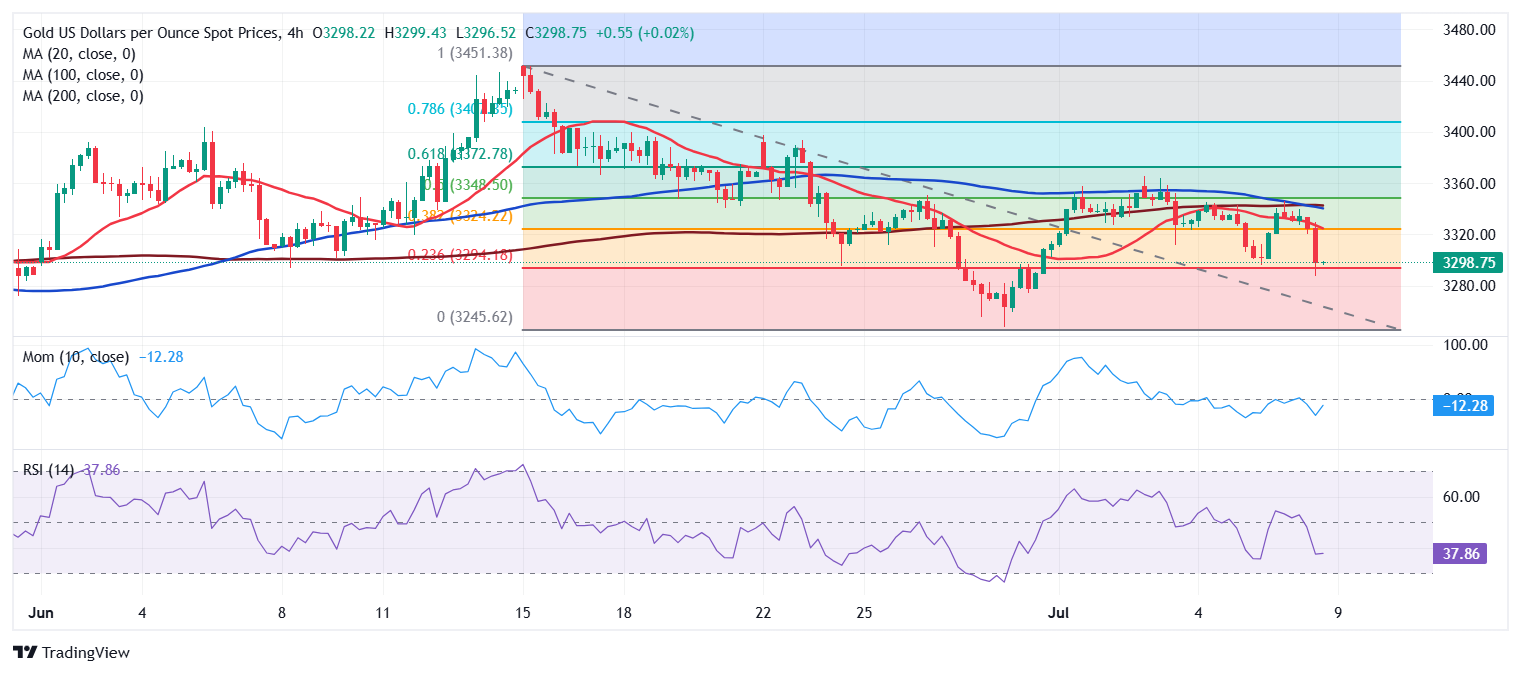XAU/USD Current price: $3,298.70
- Uncertainty related to US President Trump’s tariffs policies undermine the mood.
- The Federal Open Market Committee will release the Minutes of the June meeting.
- XAU/USD is firmly bearish in the near term and could fall towards $3,247.

Gold price kept struggling to regain its shine, unable to recover beyond the $3,350 mark, despite a risk-averse market environment. The US Dollar (USD) shed some ground throughout the first half of the day, but recovered its poise with Wall Street’s opening, advancing as stocks fell, clearly reflecting the sour market mood.
Concerns revolve around United States (US) President Trump’s latest announcement on tariffs. Late on Monday, Trump shared on Truth Social different letters he sent to trading counterparts, announcing fresh tariffs ranging from 25% to 40%. He also extended the deadline to implement levies towards August 1, while opening the door for additional extensions.
Trump aims to clinch better trading deals with most major partners, so far unable to do so. He aims to reduce the constant US external deficit and bolster local production, again, having achieved little progress on the matter.
US indexes are doing better after edging sharply lower on Tuesday. The Nasdaq Composite trades with modest gains, while the Dow Jones Industrial Average and the S&P 500 trimmed most of their pre-opening losses, still trading in the red. Market players are torn between the uncertainty about Trump’s policies and hopes that the worst-case scenario -that is, massive tariffs and skyrocketing inflation- will not take place.
Attention flips not to the Federal Open Market Committee (FOMC), scheduled to release the Minutes of the June Monetary Policy Meeting on Wednesday. The document is likely to reaffirm what speculative interest already knows, that is, that Federal Reserve (Fed) officials are comfortable with their recently adopted wait-and-see stance.
XAU/USD short-term technical outlook
The XAU/USD pair is currently piercing the $3,300 mark, and technical readings in the daily chart support another leg south. A flat 20 Simple Moving Average (SMA) converges with the 50% Fibonacci retracement of the June slide at $3,350, rejecting buyers. The pair is currently trading around the 23.6% retracement of the same slide, with a break below it opening the door for a retest of the base of the range at $3,247.83. The 100 and 200 SMAs keep heading north far below the current level. Finally, technical indicators gain downward traction within negative levels, reflecting sellers’ strength.
In the near term, and according to the 4-hour chart, the bearish case is even stronger. The XAU/USD pair accelerated south after repeated failed attempts to overcome a bearish 20 SMA, which gains downward traction below the longer ones. At the same time, technical indicators head south almost vertically, approaching oversold conditions but still with room to extend their slumps.
Support levels: 3,287.40 3,274.50 3,259.40
Resistance levels: 3,309.40 3,325.00 3,350.00
Tariffs FAQs
Tariffs are customs duties levied on certain merchandise imports or a category of products. Tariffs are designed to help local producers and manufacturers be more competitive in the market by providing a price advantage over similar goods that can be imported. Tariffs are widely used as tools of protectionism, along with trade barriers and import quotas.
Although tariffs and taxes both generate government revenue to fund public goods and services, they have several distinctions. Tariffs are prepaid at the port of entry, while taxes are paid at the time of purchase. Taxes are imposed on individual taxpayers and businesses, while tariffs are paid by importers.
There are two schools of thought among economists regarding the usage of tariffs. While some argue that tariffs are necessary to protect domestic industries and address trade imbalances, others see them as a harmful tool that could potentially drive prices higher over the long term and lead to a damaging trade war by encouraging tit-for-tat tariffs.
During the run-up to the presidential election in November 2024, Donald Trump made it clear that he intends to use tariffs to support the US economy and American producers. In 2024, Mexico, China and Canada accounted for 42% of total US imports. In this period, Mexico stood out as the top exporter with $466.6 billion, according to the US Census Bureau. Hence, Trump wants to focus on these three nations when imposing tariffs. He also plans to use the revenue generated through tariffs to lower personal income taxes.







